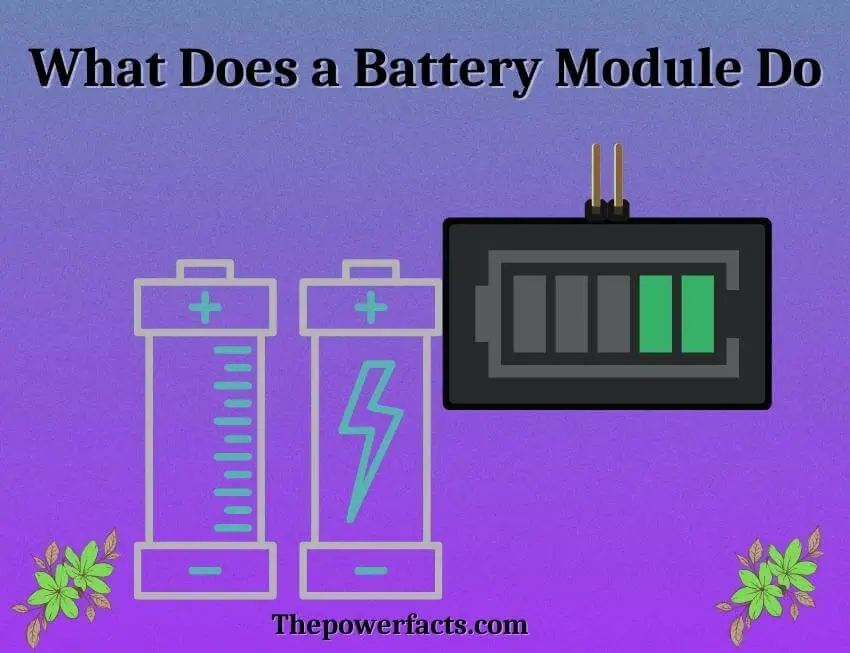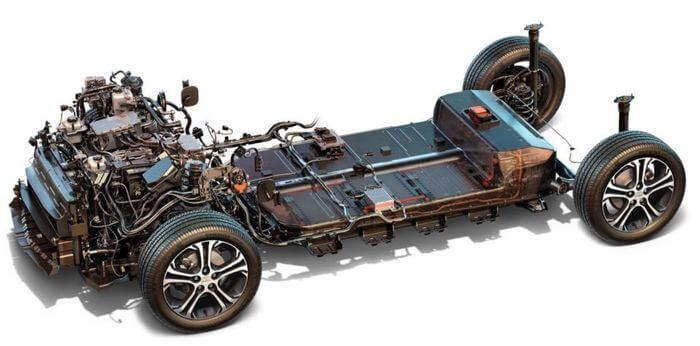A battery module is a device that provides power to an electronic device. It converts chemical energy into electrical energy. A battery module typically contains one or more batteries.

A battery module is a power source that provides electricity to devices or machines. It typically consists of one or more batteries, either connected in parallel or series and may also include a voltage regulator and/or fuse for safety. Battery modules are used in many applications, including backup power supplies, electric vehicles, and portable electronics.
What is a Car Battery Module?
A car battery module is a device that provides power to a car’s electrical system. It is made up of several batteries that are connected together in a series. The module supplies power to the car’s starter, lights, and other electrical components.
What is a Modular Battery System?
A modular battery system is a type of energy storage device that consists of multiple modules (individual batteries) that are connected together to form a larger unit. This type of system offers several advantages over traditional, single-unit batteries, including increased capacity, flexibility, and redundancy. Modular battery systems typically consist of two or more modules (batteries) that are connected in parallel or in series.
In a parallel configuration, the modules are connected so that they share the load evenly and can be used independently of each other. In a series configuration, the modules are connected so that the voltage of the system is equal to the sum of the voltages of the individual modules. Series configurations are often used when higher voltages are required, such as in electric vehicles.
They Offer Increased Capacity Over Traditional Single-unit Batteries
One advantage of modular battery systems is that they offer increased capacity over traditional single-unit batteries. This is because multiple modules can be used together to store more energy than a single unit. Additionally, modular systems offer greater flexibility in terms of how they can be configured to meet specific needs.
For example, a parallel configuration may be used for applications where high currents are required, while a series configuration may be better suited for applications where high voltages are needed.
They Provide Redundancy in Case One Module Fails
Another advantage of modular battery systems is that they provide redundancy in case one module fails. With a traditional single-unit battery, if one cell fails then the entire battery must be replaced.
However, with a modular system, only the failed module needs to be replaced – meaning there is no need for an expensive and time-consuming replacement process. Additionally, because modular systems use multiple units which can operate independently from each other if one module fails it will not affect the performance or capacity of the remaining modules.
How Many Batteries Modules are in a Tesla?
The Tesla Model S has a battery composed of 16 modules. Each module contains 6 bipolar cells in series for a total of 96 cells. The cell size is about 10 times larger than a AA battery.
What is a Lithium-Ion Battery Module?
Lithium-ion batteries are becoming increasingly popular in a variety of applications, from portable electronics to electric vehicles. A lithium-ion battery module is a pack of individual lithium-ion cells connected together to provide a higher voltage and/or current output than a single cell. Cell phone batteries are often made up of multiple modules connected in series or parallel, providing the necessary 3.6-4.2 volts for most phones.
Large-format lithium-ion batteries used in electric vehicles may have hundreds of modules connected together, providing hundreds or even thousands of volts. Each module in a battery pack must be carefully designed to ensure safe operation. The module must be able to dissipate heat generated during charging and discharging, as well as during any external short circuits that may occur.
The individual cells within the module must also be protected from overcharging and over-discharging, which can damage the cell and potentially cause a fire. With careful design, lithium-ion battery modules can provide a safe and reliable source of power for many different applications.
Disadvantages of Battery Management System
The disadvantages of a battery management system are that it can be expensive, and it can require regular maintenance. Additionally, if there is a power outage, the batteries will need to be replaced.
Battery Module Components
A battery module is a self-contained unit that contains one or more batteries, along with the necessary electronics to control charging and discharge. A typical battery module will contain a charger, a discharge controller, and one or more batteries. The charger is responsible for keeping the batteries charged.
It does this by monitoring the voltage of each cell in the battery and shutting off when the voltage reaches a certain level. The discharge controller monitors the current draw of the system and shuts off when it reaches a certain level. This prevents the batteries from being discharged too deeply, which can damage them.
The batteries themselves are typically Lithium Ion (Li-Ion) or Lead Acid (PbA) cells. Li-Ion cells are smaller and lighter than PbA cells, but they are also more expensive. PbA cells are less expensive but heavier and larger.
Both types of cells have their advantages and disadvantages, so it’s important to choose the right type for your application. Lithium Ion batteries have a higher energy density than Lead Acid batteries, meaning they can store more energy in a given space. They also have a lower self-discharge rate, meaning they lose less energy over time when not in use.
However, they are more sensitive to temperature extremes and can be damaged if discharged too deeply. Lead Acid batteries are much cheaper than Lithium Ion batteries, but they are also heavier and larger. They don’t perform as well in extreme temperatures, but they are more tolerant of deep discharge cycles.

What is Battery Pack?
A battery pack is a power source that contains one or more batteries. Battery packs are used in a variety of devices, including cell phones, laptops, and remote control vehicles. Many battery packs contain rechargeable batteries, which can be used over and over again.
Battery packs come in a variety of shapes and sizes, depending on the device they will be powering. Some battery packs are very small, like those found in hearing aids or watches. Others are much larger, like those used in electric cars.
The size of the battery pack will determine how long it can power the device and how much electricity it can store. Most battery packs contain multiple batteries connected together in series or parallel. This allows the pack to provide more power than a single battery would be able to alone.
Series connection means that the positive terminal of one battery is connected to the negative terminal of the next battery in line. A parallel connection means that all of the positive terminals are connected together, and all of the negative terminals are connected together. Battery Packs can be made from many different types of batteries including Lithium Ion (Li-Ion), Nickel Metal Hydride (NiMH), lead acid, and alkaline batteries among others.
The type of battery used will usually dictate both the cost and performance characteristics such as specific energy (energy per unit mass), specific power(power per unit mass), and cycle life(the number of times until discharge capacity falls below a certain percentage).
Battery Module Vs Pack
When it comes to electric vehicles, there are a lot of different parts and pieces that go into making them run. One important component is the battery module or pack. Both the module and pack serve an important purpose in the overall operation of an electric vehicle, but there are some key differences between them.
The battery module is made up of a series of individual batteries that are connected together. Each battery within the module provides a certain amount of power output. The modules are typically used in smaller electric vehicles, such as golf carts or scooters.
The battery pack, on the other hand, is made up of larger batteries that are connected together in a parallel fashion. This type of configuration allows for more power output than what you would get from a single battery module. Battery packs are typically used in larger electric vehicles, such as cars or buses.
Car Battery Module
When your car battery dies, it’s not always necessary to replace the entire battery. In some cases, you may be able to replace just the module. A car battery module is a small, self-contained unit that includes the positive and negative terminals, as well as the cells.
Module replacement is often less expensive than replacing an entire battery, and it can be a good option if only one or two of the cells in your battery are damaged. To replace a car battery module, first, disconnect the old module from the rest of the battery. Then, connect the new module in its place and secure it with bolts or clamps.
Finally, reconnect any wires or cables that were attached to the old module. If you’re not comfortable replacing a car battery module yourself, you can always take it to a professional mechanic or auto shop for assistance.
EV Battery Cell Types
There are many different types of batteries, but when it comes to electric vehicles (EVs), the three most common types of battery cells are lithium-ion (Li-ion), nickel metal hydride (NiMH), and lead acid. Lithium-ion batteries are the most popular type of EV battery cell. They offer a high energy density, meaning they can store a lot of energy in a small space.
Li-ion batteries are also lightweight and have a long lifespan. The downside is that they can be expensive. NiMH batteries are not as popular as Li-ion batteries, but they offer some advantages.
NiMH batteries are cheaper than Li-ion batteries and don’t require special charging equipment. However, NiMH batteries are heavier than Li-ion batteries and have a lower energy density. Lead acid batteries were once the most popular type of EV battery cell, but they have been largely replaced by Li-ion and NiMH batteries.
Lead acid batteries are very heavy and have a low energy density. They also require frequent maintenance and can be dangerous if not handled properly.
Cell-To-Pack Battery
Cell-To-Pack Battery A cell-to-pack battery is a type of rechargeable battery in which the cells are packaged together in a single unit. This type of battery is often used in electronic devices, such as laptop computers and cell phones.
Cell-to-pack batteries typically have a higher capacity than other types of batteries, making them ideal for devices that require a lot of power. Cell-to-pack batteries are made up of several smaller cells that are connected together. The number of cells in a cell-to-pack battery can vary, but most contain between four and eight cells.
The cells are usually made from lithium ion, nickel metal hydride, or lead acid. Cell-to-pack batteries typically have a voltage of 3.6 volts or more. Cell-to-pack batteries are recharged by plugging the device into an electrical outlet.
The charging time can vary depending on the size of the battery and the amount of power required to fully charge it. Most cell-to-pack batteries take between two and four hours to fully charge.
Final Thoughts
A battery module is a device that helps to regulate the voltage and current in a battery. It is typically used in conjunction with a solar panel or another renewable energy source. The battery module can be used to store energy, convert it to another form of energy, or release it when needed.